Page 865 - TNFlipTest
P. 865
Toronto Notes 2019
Hypertensive Disorders of Pregnancy
Obstetrics OB25
• visualdisturbances–blurring,scotomata • tremulousness, irritability, somnolence
• hyperreflexia
■ hematologic
• bleeding, petechiae
■ hepatic
• RUQorepigastricpain • severeN/V
■ renal
• urineoutputandcolour
■ non-dependent edema (i.e. hands and face) • evaluationoffetus
■ fetal movement
■ fetal heart rate tracing – NST ■ U/S for growth
■ BPP
■ Doppler flow studies
Laboratory Evaluation of Hypertensive Disorders in Pregnancy
• CBC
• PTT, INR, fibrinogen – if abnormal LFTs or bleeding
• ALT, AST
• creatinine,uricacid
• 24hurinecollectionforproteinoralbumin:creatinineratio
• placentalgrowthfactor(PlGF)testingalongwithstandardclinicalandlaboratoryinvestigationsis
recommended to help “rule out” preeclampsia in cases of suspected preeclampsia. There is insufficient evidence to recommend its use to rule in (diagnose) preeclampsia
Complications of Hypertensive Disorders in Pregnancy
• maternal
■ liver and renal dysfunction
■ seizure - “eclampsia”
■ abruptio placentae
■ left ventricular failure/pulmonary edema
■ DIC (release of placental thromboplastin consumptive coagulopathy) ■ HELLPsyndrome
■ hemorrhagic stroke (50% of deaths)
• fetal(2°toplacentalinsufficiency)
■ IUGR, prematurity, abruptio placentae, IUFD
Management of HTN
• fornon-severeHTN(149-159/90-105)targetaBPof130-155/80-105inwomenwithoutcomorbidities or <140/90 in women with comorbidities
• forbothpre-existingandgestationalHTN,labetalol100-400mgPObid-tid,nifedipineXLpreparation 20-60 mg PO od, or α-methyldopa 250-500 mg PO bid-qid
• forsevereHTN(BP>160/110),giveoneof:
■ labetalol 20 mg IV then 20-80 mg IV q30min (max 300 mg) (then switch to oral) ■ nifedipine 5-10 mg capsule q30min
◆ hydralazine 5 mg IV, repeat 5-10 mg IV q30min or 0.5 to 10 mg/hr IV, to a maximum of 20 mg IV(or30mgIM)
• noACEI,ARBs,diuretics(incasesofpulmonaryedemaorcardiacfailure,maybeused),prazosin,or atenolol
• pre-existingHTNandgestationalHTNwithoutanydeteriorationcanbefolloweduntil37wk,then decide to induce shortly thereafter
Management of Preeclampsia
• if stable and no adverse factors (GA 24-33+6 wk), expectant management, ± delivery as approaching 34-36 wk (must weigh risks of fetal prematurity vs. risks of developing severe preeclampsia/eclampsia)
• antenatal corticosteroids should be considered if GA ≤ 34+6 wk • if >37 wk, immediate delivery is recommended
• forseverepreeclampsia,stabilizeanddeliver,regardlessofGA
• ifseverepreeclampsiaduringlabour,increasematernalmonitoring:hourlyinputandoutput,urinedip
q12h, hourly neurological vitals, and increase fetal monitoring (continuous FHR monitoring)
• antihypertensive therapy
■ labetalol 20 mg IV, then 20-80 mg IV q30min (max 300 mg) (then switch to oral) ■ nifedipine 5-10 mg capsule q30min
◆ hydralazine 5 mg IV, repeat 5-10 mg IV q30min or 0.5-10 mg/hr IV, to a maximum of 20 mg IV (or 30 mg IM)
I-A Evidence-Recommendation Highlights of SOGC Clinical Practice Guidelines
Diagnosis, Evaluation, and Management of the Hypertensive Disorders of Pregnancy
J Obstet Gynaecol Can 2014;36(5):416-438
• ForBPmeasurement,KorotkoffphaseVshould
be used to designate the dBP.
• Calciumsupplementation(ofatleast1g/d,orally)
is recommended for women with low dietary
intake of calcium (<600 mg/d). (I-A)
• Forpreeclampsiapreventionamongincreased
risk women, low-dose Aspirin® (75-100 mg/d) is
recommended until delivery.
• UmbilicalarteryDopplervelocimetryshould
be part of the antenatal fetal surveillance in
preeclampsia.
• Initialantihypertensivetherapyforsevere
HTN (sBP >160 or dBP ≥110) should be with
labetalol, nifedipine, or hydralazine.
• Initialantihypertensivetherapyfornon-severe
HTN (BP 140-159/90-109 mmHg) should be with methyldopa, β-blockers, or calcium channel blockers.
• Antenatalcorticosteroidsforfetallung maturation should be considered for all women with preeclampsia before 34 wk gestation.
• Inaplannedvaginaldeliverywithan unfavourable cervix, cervical ripening should be used.
• Oxytocin5unitsIVor10unitsIMshouldbe used as part of the management during the third stage of labour, particularly in the presence of thrombocytopenia or coagulopathy.
• Magnesium sulfate is the recommended first-line treatment for eclampsia.
• Magnesiumsulfateistherecommended eclampsia prophylaxis in severe preeclampsia.
Preeclampsia Investigations
• CBC
• AST, ALT
• INR and aPTT (if abn LFTs or bleeding)
• Cr
• Urine (24 h protein collection or albumin/
creatinine ratio) • Uric acid


